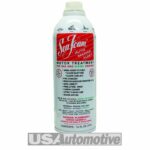Ever wondered what fuels the ferocious roar and blistering speed of top fuel dragsters and high-performance model engines? It’s nitromethane, a fuel with an explosive personality. This comprehensive guide explores the multifaceted world of nitromethane—its chemical properties, diverse applications, crucial safety considerations, intriguing history, and potential environmental impact. Whether you’re a seasoned motorsports enthusiast or simply curious about this potent liquid, this article offers a deep dive into the world of “nitro.”
Understanding Nitromethane’s Chemical Powerhouse
Nitromethane (CH₃NO₂) is more than just a fuel; it’s a self-oxidizing power pack. Unlike gasoline, which requires atmospheric oxygen for combustion, nitromethane carries its own oxygen supply within its molecular structure. This unique characteristic allows it to burn efficiently even in oxygen-limited environments, like the tightly packed cylinder of a high-performance engine. This results in a significantly higher energy output compared to traditional fuels, making it the go-to choice for applications where extreme power is paramount. Warm up your meals quickly and easily, even in the most remote locations, with a reliable MRE heater.
Nitromethane’s Explosive Energy: A Closer Look
Nitromethane’s power stems from its ability to burn a much richer fuel mixture than gasoline. While gasoline requires a specific air-fuel ratio (around 14.7:1), nitromethane, with its internal oxygen supply, needs significantly less air. Sources suggest it requires only 1.7kg of air per kilogram of fuel, allowing approximately eight times more fuel to be burned with the same amount of air compared to gasoline. This translates into a massive power surge, making it ideal for high-performance racing where every ounce of energy counts.
From Drag Strips to Model Engines: Nitromethane’s Applications
Nitromethane’s claim to fame is undoubtedly its use in Top Fuel drag racing. These monstrous machines, capable of generating over 10,000 horsepower, rely on a carefully balanced mixture of nitromethane and methanol (typically 10-40% nitromethane). Pure nitromethane is generally too potent for practical use in most engines, requiring specialized design and maintenance. However, its influence extends beyond the professional racing circuit. Hobbyists utilize nitromethane in varying concentrations (0-25%) to boost the performance of model engines in RC cars, airplanes, boats, and other miniature speed demons. Beyond motorsports, nitromethane also plays a role in industrial chemistry, serving as a building block for compounds like pesticides, buffers, and resins, and acting as a specialized solvent. For those intricate tasks that demand precision and a secure grip, explore the versatility of needle nose vise grips and conquer any challenge.
Taming the Beast: Nitromethane Safety and Handling
Nitromethane’s impressive power comes with a responsibility for careful handling. While its toxicity is moderate, its high volatility and explosive potential demand respect. It’s essential to adhere to strict safety protocols:
- Storage: Store nitromethane in approved, tightly sealed containers away from heat and open flames.
- Handling: Always wear appropriate safety gear, including gloves, eye protection, and a respirator. Ensure adequate ventilation to prevent fume buildup.
- Spill Response: Have a plan in place for safely cleaning up spills and disposing of contaminated materials.
- Emergency Procedures: Familiarize yourself with emergency procedures for nitromethane-related incidents.
Nitromethane and the Environment: An Ongoing Investigation
The environmental impact of nitromethane is a complex issue currently under investigation. While its combustion byproducts differ from gasoline, the long-term effects are still being studied. Some research suggests potential benefits, such as reduced emissions of certain pollutants, while others highlight concerns about the formation of other harmful substances. The scientific community continues to explore these complexities, searching for a clearer understanding of nitromethane’s environmental footprint and investigating the potential of sustainable alternatives like bio-derived nitromethane.
Why Did NHRA Ban Nitromethane? A Tale of Speed and Safety
In the early days of drag racing, the raw power of nitromethane fueled both record-breaking speeds and dangerous engine failures. The NHRA, led by Wally Parks, banned nitromethane in 1957 due to escalating safety concerns. This ban wasn’t solely targeted at nitromethane; the NCCOA (North Coast Competition Coupe Owners Association) also raised concerns about other “liquid explosives” like those used in Novis cars (acetone, propylene oxide, benzene, and hydrazine). However, nitromethane’s performance advantages proved too compelling to ignore. With improved safety regulations and engine technology, the ban was lifted in 1962, marking nitromethane’s return to the drag strip and its eventual dominance in Top Fuel racing.
What Does Nitromethane Do to an Engine?
Nitromethane’s impact on an engine is profound. Its unique chemistry allows it to deliver an explosive power boost, but this comes with specific requirements. Specialized engine components, including reinforced blocks and robust cooling systems, are essential to withstand the extreme heat and pressure generated during combustion. Attempting to use nitromethane in a standard engine designed for gasoline would be disastrous.
Is Nitromethane a Good Fuel? It Depends…
Nitromethane is undoubtedly a powerhouse when it comes to performance, but its practicality is limited by its volatility, cost, and specialized engine demands. While not suitable for everyday driving, its unparalleled power output makes it the fuel of choice for high-performance racing and certain niche applications.
| Feature | Nitromethane | Gasoline |
|---|---|---|
| Oxygen Content | High (internal) | Low (relies on air intake) |
| Power Output | Extremely High | Moderate |
| Volatility | Very High | Moderate |
| Cost | Very High | Low |
| Practicality | Racing and specialized uses | Everyday transportation |
| Engine Needs | Specialized, reinforced | Standard automotive |
| Safety Concerns | High | Moderate |
This comprehensive guide aims to provide a well-rounded understanding of nitromethane. While the information presented here is based on current research and understanding, ongoing studies may reveal new insights and perspectives. It’s important to always consult with experts and refer to official safety guidelines before handling or using nitromethane.
- Unlock Elemental 2 Secrets: Actionable Insights Now - April 2, 2025
- Lot’s Wife’s Name: Unveiling the Mystery of Sodom’s Fall - April 2, 2025
- Photocell Sensors: A Complete Guide for Selection and Implementation - April 2, 2025















